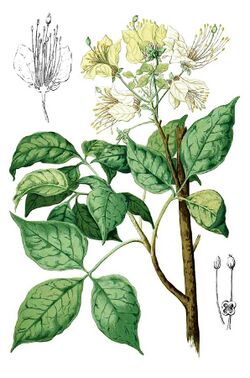Biology:Crateva religiosa
From HandWiki
Short description: Species of flowering plant
| Crateva religiosa | |
|---|---|

| |
| Scientific classification | |
| Kingdom: | Plantae |
| Clade: | Tracheophytes |
| Clade: | Angiosperms |
| Clade: | Eudicots |
| Clade: | Rosids |
| Order: | Brassicales |
| Family: | Capparaceae |
| Genus: | Crateva |
| Species: | C. religiosa
|
| Binomial name | |
| Crateva religiosa | |
| Synonyms | |
| |
Crateva religiosa, the sacred garlic pear or temple plant, is a species of flowering tree. It is a member of the capers family. The tree is sometimes called the spider tree because the showy flowers bear long, spidery stamens. It is native to much of tropical Asia and several South Pacific islands.[1] It is grown elsewhere for fruit, especially in parts of the African continent.
The garlic pear tree is a perennial that can grow up to 15 m (49 ft). The nectar-filled flowers are attractive to a multitude of insects and birds. A pierid butterfly, Hebomoia glaucippe, is a frequent visitor to this plant.
The chemical compound lupeol can be extracted from the bark of C. Religiosa.[2]
References
- ↑ 1.0 1.1 Botanic Gardens Conservation International (BGCI).; IUCN SSC Global Tree Specialist Group (2019). "Crateva religiosa". IUCN Red List of Threatened Species 2019: e.T32627A145369995. doi:10.2305/IUCN.UK.2019-2.RLTS.T32627A145369995.en. https://www.iucnredlist.org/species/32627/145369995. Retrieved 20 November 2021.
- ↑ Patil, Udaysing; D.K, Gaikwad (2011). "Medicinal Profile of a Scared Drug in Ayurveda: Crataeva Religiosa". Journal of Pharmaceutical Sciences and Research 3: 923–929.
Wikidata ☰ Q311133 entry
 |


